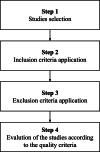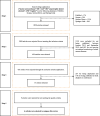National registry for amyotrophic lateral sclerosis: a systematic review for structuring population registries of motor neuron diseases
- PMID: 34229610
- PMCID: PMC8259351
- DOI: 10.1186/s12883-021-02298-2
National registry for amyotrophic lateral sclerosis: a systematic review for structuring population registries of motor neuron diseases
Abstract
Background: This article comprises a systematic review of the literature that aims at researching and analyzing the frequently applied guidelines for structuring national databases of epidemiological surveillance for motor neuron diseases, especially Amyotrophic Lateral Sclerosis (ALS).
Methods: We searched for articles published from January 2015 to September 2019 on online databases as PubMed - U.S. National Institutes of Health's National Library of Medicine, Scopus, Science Direct, and Springer. Subsequently, we analyzed studies that considered risk factors, demographic data, and other strategic data for directing techno-scientific research, calibrating public health policies, and supporting decision-making by managers through a systemic panorama of ALS.
Results: 2850 studies were identified. 2400 were discarded for not satisfying the inclusion criteria, and 435 being duplicated or published in books or conferences. Hence, 15 articles were elected. By applying quality criteria, we then selected six studies to compose this review. Such researches featured registries from the American (3), European (2), and Oceania (1) continent. All the studies specified the methods for data capture and the patients' recruitment process for the registers.
Discussions: From the analysis of the selected papers and reported models, it is noticeable that most studies focused on the prospect of obtaining data to characterize research on epidemiological studies. Demographic data (ID01) are present in all the registries, representing the main collected data category. Furthermore, the general health history (ID02) is present in 50% of the registries analyzed. Characteristics such as access control, confidentiality and data curation. We observed that 50% of the registries comprise a patient-focused web-based self-report system.
Conclusion: The development of robust, interoperable, and secure electronic registries that generate value for research and patients presents itself as a solution and a challenge. This systematic review demonstrated the success of a population register requires actions with well-defined development methods, as well as the involvement of various actors of civil society.
Keywords: Amyotrophic lateral sclerosis; Global health; Motor neuron disease; National databases of epidemiological; Rare disease registries.
Conflict of interest statement
The authors declare that they have no competing interests.
Figures



Similar articles
-
Prevalence of Amyotrophic Lateral Sclerosis - United States, 2012-2013.MMWR Surveill Summ. 2016 Aug 5;65(8):1-12. doi: 10.15585/mmwr.ss6508a1. MMWR Surveill Summ. 2016. PMID: 27490513
-
Prevalence of amyotrophic lateral sclerosis - United States, 2010-2011.MMWR Suppl. 2014 Jul 25;63(7):1-14. MMWR Suppl. 2014. PMID: 25054277
-
Estimating Amyotrophic Lateral Sclerosis and Motor Neuron Disease Prevalence in Portugal Using a Pharmaco-Epidemiological Approach and a Bayesian Multiparameter Evidence Synthesis Model.Neuroepidemiology. 2019;53(1-2):73-83. doi: 10.1159/000499485. Epub 2019 May 22. Neuroepidemiology. 2019. PMID: 31117082
-
Regulatory T cells for amyotrophic lateral sclerosis/motor neuron disease: A clinical and preclinical systematic review.J Cell Physiol. 2020 Jun;235(6):5030-5040. doi: 10.1002/jcp.29401. Epub 2019 Dec 1. J Cell Physiol. 2020. PMID: 31788795
-
Motor Neuron Disease Population-Based Registry in Egypt: Where Do We Stand?Neuroepidemiology. 2025;59(3):277-289. doi: 10.1159/000539468. Epub 2024 Jun 13. Neuroepidemiology. 2025. PMID: 38870925 Review.
Cited by
-
Blockchain in Health Information Systems: A Systematic Review.Int J Environ Res Public Health. 2024 Nov 14;21(11):1512. doi: 10.3390/ijerph21111512. Int J Environ Res Public Health. 2024. PMID: 39595779 Free PMC article.
-
Evaluation of the therapeutic effects of rehabilitation therapy on patients with amyotrophic lateral sclerosis-a meta-analysis.Front Neurol. 2024 May 3;15:1389146. doi: 10.3389/fneur.2024.1389146. eCollection 2024. Front Neurol. 2024. PMID: 38765269 Free PMC article.
-
Prognostic Factors and Epidemiology of Amyotrophic Lateral Sclerosis in Southeastern United States.Mayo Clin Proc Innov Qual Outcomes. 2024 Sep 17;8(5):482-492. doi: 10.1016/j.mayocpiqo.2024.07.008. eCollection 2024 Oct. Mayo Clin Proc Innov Qual Outcomes. 2024. PMID: 39323877 Free PMC article.
-
Electronic health records in Brazil: Prospects and technological challenges.Front Public Health. 2022 Nov 3;10:963841. doi: 10.3389/fpubh.2022.963841. eCollection 2022. Front Public Health. 2022. PMID: 36408021 Free PMC article.
-
Translational research in health technologies: A scoping review.Front Digit Health. 2022 Aug 3;4:957367. doi: 10.3389/fdgth.2022.957367. eCollection 2022. Front Digit Health. 2022. PMID: 35990015 Free PMC article.
References
-
- Sherman A, Gubitz A, Al-Chalabi A, Bedlack R, Berry J, Conwit R, Harris B, Horton D, Kaufmann P, Leitner M, Miller R, Shefner J, Vonsattel J, Mitsumoto H. Infrastructure resources for clinical research in amyotrophic lateral sclerosis. Amyotroph Lateral Scler Frontotemporal Degener. 2013;14(sup1):53–61. doi: 10.3109/21678421.2013.779058. - DOI - PubMed
Publication types
MeSH terms
LinkOut - more resources
Full Text Sources
Medical
Miscellaneous

